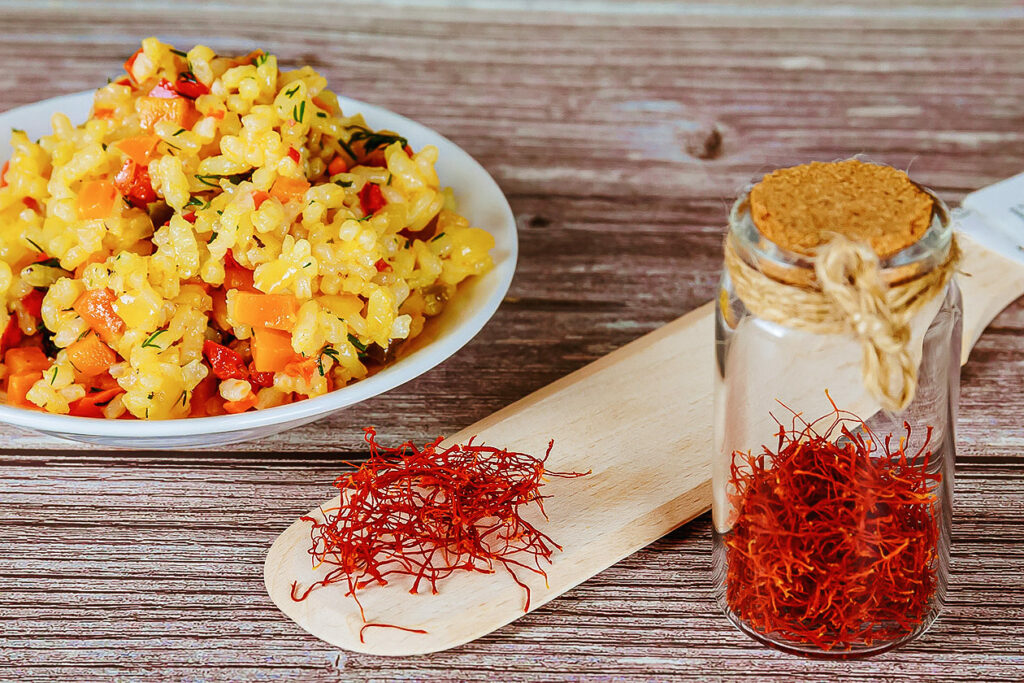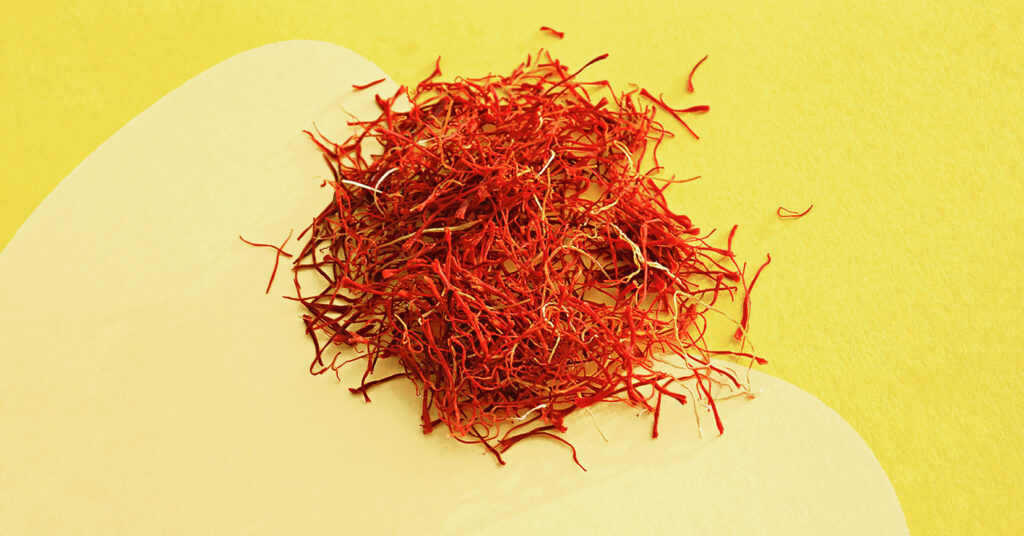Saffron is many things: it’s a spice, a hue, and a natural dye. It’s a fragrance note in perfumes and cosmetics and an ingredient in holistic medicines. And it’s the most expensive seasoning in the world.
Saffron isn’t common in many American kitchens, but its rich, floral spice enlivens dishes, adding exciting flavor notes. For Chef John Cleveland, owner of Post & Beam in Los Angeles, saffron is a favorite spice, especially for mycophiles. “Saffron’s earthy, pungent notes perfectly complement mushrooms and rice dishes,” Cleveland said.
Saffron’s wide availability makes it an excellent choice for expanding your seasoning repertoire. Saffron is easy to source, and excellent for cooking Indian and Middle Eastern cuisine.
Ready to learn cook with saffron and add its inimitable color and aroma to your entrees, side dishes, and cocktails? It’s an absolutely golden time to get friendly with these valuable crimson threads.
What is saffron?
Saffron is the most expensive seasoning in the world for a reason. “Saffron is historically expensive because of its difficult harvesting process,” Cleveland said.
Within the blossom of Crocus sativus, also known as saffron crocuses, are pistils that catch the pollen that allows the plant to reproduce. A special receptor called a stigma lies within that pistil, which produces a natural adhesive to trap and hold pollen for maximum reproductive efficiency.
A deep red strand about the thickness of dental floss, about an inch or so long, saffron comes from that stigma. Harvesters painstakingly hand-harvest saffron from these stigmas in order to preserve the thread’s length.
Longer strands are prized for their quality and integrity. In fact, the finest saffron on the market can cost more than its weight in gold (up to $5,000 per pound).
Saffron’s history
Saffron originates in the Middle East and Central Asia. People have cultivated it for thousands of years.
Saffron serves wide range of purposes, from flavoring regional dishes to serving as a traditional remedy for a lengthy list of ailments.
You’re most likely to find saffron in dishes with roots in Asia Minor (the region surrounding modern-day Turkey), including Italy, Greece, Macedonia, Bulgaria, and throughout the Middle East and Indian Subcontinent.
What does saffron taste like?
This coveted spice smells earthy and sweet, with flavor notes of almond, rose, and honey. If you’re unaccustomed to floral flavors, you may find saffron to be overly perfumey or even “soapy” until your palates acclimates, since there’s nothing even close to an equivalent in the typical American pantry. Saffron carries a uniquely honeyed floral taste that’s difficult to describe until you taste it.
Introduce a new flavor to your kitchen by learning how to cook with saffron. Saffron offers versatility, ease of use, and the ability to transform both simple and complex meals into regal feasts.
How to cook with saffron: 6 recipe ideas

Create a saffron concentrate
You can add saffron directly to a dish, but there’s a way to make the flavor go farther for your buck. “We infuse the saffron in water because that is the most effective way to season,” Cleveland said. “You can use saffron powders or spice blends, but you will not get the full flavor of using fresh threads and creating a saffron concentrate.”
To make the concentrate, steep saffron in a couple of tablespoons of boiling water. You’ll create a vivid concentrate that you can diffuse evenly into grain cooking liquid, braises, and sauces. Extra-fragrant herbs like basil, tarragon, and cilantro, as well as warm spices like cumin, coriander, and paprika, can easily overpower saffron. For that reason, shine the spotlight on saffron’s flavor and save those other herbs for another dish.

Make the best beans ever
Saffron adds a distinguished aroma and flavor to beans that ups your game significantly. If you’re tired of the same old beans, add a strand or two of saffron to your Instant Pot or slow cooker. Moroccan beans with saffron can be made with any kind of small white bean, including cannellinis.

Whip up some dessert
Desserts lend themselves perfectly to saffron’s earthy, honeyed flavors. Rice pudding is an easy option for saffron, from Persian sholeh zard to Indian shrikhand. If you’ve got a bit more time, try your hand at saffron cardamom milk cake, or Persian bamieh donuts. Saffron is also an ideal addition to ice cream and kulfi. You can substitute plant-based dairy products easily in most of these recipes, from milk to yogurt and even eggs.

Mix cocktails with saffron
It’s exceptionally easy to infuse spirits with saffron. Simply drop a large pinch of threads—about 20 or so—straight into the bottle. Let it sit for three or four days (depending on how strong you’d like the flavor to be), shaking once a day. Vodka, gin, rum, and tequila are all delicious with a boost of saffron essence. Mix cocktails with saffron-friendly flavors like orgeat, cinnamon, ginger, mint, lemon, and bitters.

Cook with saffron in rice and grains
Infuse saffron into any kind of rice, including arborio, jasmine, brown, Spanish rice, and even pilaf. Cook with saffron in whole grains like farro and wheat berries. You can also cook saffron in starches like traditional and Israeli couscous, to add color and aroma. To do so, first create saffron water with Chef John’s recipe below, adding three saffron threads to one cup of boiled water and one cup of white wine, and letting the saffron infuse for 20 minutes.

Add saffron to potato dishes
Cook with saffron to impart an extra-yellow hue that just screams “potatoes!” Add whole threads or a tablespoon of steeped saffron essence to potato salad dressing, potato casseroles, and even mashed potatoes for color and complexity.

Make saffron tea
Looking to experience saffron in all its complex glory? You’ll need to cook with saffron in the simplest way possible.
Boil four to five cups of water in a pot. Remove from heat and add a pinch of threads (about 15 total). Steep for five minutes, and sweeten with sugar, vegan honey, or agave if desired.
Like what you taste? We thought you might! Build on your newfound love of saffron tea by tossing in any combination of ginger root, cinnamon sticks, and cardamom pods or seeds.
Ground saffron vs. saffron threads
Made from the by-products of saffron processing, like broken threads, dry plant matter, and the bits that fall to the bottom of bags and bins, ground saffron is a lower-quality product than whole unground strands.
This ground saffron is significantly more affordable than its whole counterpart. The ground version contains neutral-flavored natural fiber like safflower, or other orange and red-hued spices like paprika and turmeric. These spices contribute their own decidedly un-saffron-like flavors. Additives dilute the remaining saffron flavor and aroma in the mix. Though ground saffron is an imperfect substitute for the real deal, it’s a perfectly serviceable way to infuse savory grains, doughs, and sauces with an eye-pleasing golden hue.
How to take care of saffron
Store saffron in an airtight glass container in a cool, dry place. Avoid storing saffron in plastic containers, as the powerful aroma will permeate the material forever (no joke). Stored properly, saffron will retain its potency for at least two years. Airtight freshness will mean you can cook with saffron whenever the fancy strikes you. If you detect a ho-hum whiff instead of its typical olfactory wallop, it’s time to replace it.
The perfect starter saffron recipe
Post & Beam’s Heirloom Grain Bowl with Saffron Rice is an easy way to use up seasonal fall squash while getting in on two trends: grain bowls and super flavorful seasoned rice. The bowl combines earthy and aromatic flavors for the perfect fall brunch.
“The idea was to create a balance of flavor between umami notes from the mushroom and rice, with aromatics and seasonal roasted vegetables,” Cleveland said.

Our “How the F@#! Do I Cook With” series explores the mouthwatering, practical, awe-inspiring, and infuriating qualities of kitchen ingredients. What ingredient has you stumped? Write to us at editorial@livekindly.com with the subject line “How Do I Cook With” and then name your ingredient!


